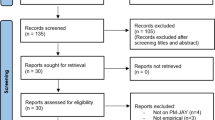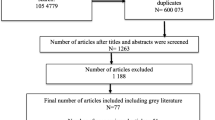Abstract
As national HIV prevention goals aim to increase the proportion of persons living with HIV, determining existing disparities in retention in care will allow for targeted intervention. The purpose of this systematic review was to identify existing disparities in retention in care. The Preferred Reporting Items for Systematic Reviews and Meta-Analysis Protocols (PRISMA-P) 2015 guided this systematic review. Electronic databases, including PubMed/MEDLINE, CINAHL, Sociological Collection, PsychInfo, and Cab Direct/Global Health, were systematically searched and twenty studies were included. This review identified disparities in retention in care that have been documented by race, gender, age, HIV exposure, incarceration history, place of birth, and U.S. geographic location. Research is necessary to further identify existing disparities in retention in care and to better understand determinants of health disparities. Additionally, interventions must be tailored to meet the needs of health disparate populations and should be assessed to determine their effectiveness in reducing health disparities.

Similar content being viewed by others
References
Centers for Disease Control and Prevention (2017) Monitoring selected national HIV prevention and care objectives by using HIV surveillance data—United States and 6 dependent areas. HIV Surveillance Supplemental Report 2019, 24(3)
The White House (2016) National HIV/AIDS strategy for the United States: updated to 2020
Mugavero MJ, Amico KR, Westfall AO, Crane HM, Zinski A, Willig JH, et al. Early retention in HIV care and viral load suppression: implications for a test and treat approach to HIV prevention. J Acquir Immun Defic Syndr. 2012;59(1):86–93.
Colasanti J, Kelly J, Pennisi E, Hu YJ, Root C, Hughes D, et al. Continuous retention and viral suppression provide further insights into the HIV care continuum compared to the cross-sectional HIV care cascade. Clin Infect Dis. 2016;62(5):648–54.
Crawford TN, Sanderson WT, Thornton A. Impact of poor retention in HIV medical care on time to viral load suppression. J Int Assoc Provid AIDS Care. 2014;13(3):242–9.
Tripathi A, Youmans E, Gibson JJ, Duffus WA. The impact of retention in early HIV medical care on viro-immunological parameters and survival: a statewide study. AIDS Res Hum Retrovir. 2011;27(7):751–8.
Eisinger RW, Dieffenbach CW, Fauci AS. HIV viral load and transmissibility of HIV infection: undetectable equals untransmittable. JAMA. 2019;321(5):451–2.
Williams MB, Mitchell F, Thomson GE. Examining the health disparities research plan of the National Institutes of Health: unfinished business. Washington: National Academies Press; 2006.
Steele CB, Melendez-Morales L, Campoluci R, DeLuca N, Dean HD (2007) Health disparities in HIV/AIDS, viral hepatitis, sexually transmitted diseases, and tuberculosis: issues, burden, and response, a retrospective review 2000–2004. Centers for Diseaes Control and Prevention
Moher D, Shamseer L, Clarke M, Ghersi D, Liberati A, Petticrew M, et al. Preferred reporting items for systematic review and meta-analysis protocols (PRISMA-P) 2015 statement. Syst Rev. 2015;4:1.
Carter-Pokras O, Baquet C. What is a “health disparity”? Public Health Rep. 2002;117(5):426–34.
Keppel K, Pamuk E, Lynch J, Carter-Pokras O, Kim I, Mays V, et al. Methodological issues in measuring health disparities. Vital Health Stat. 2005;141:1–16.
Mugavero MJ, Westfall AO, Zinski A, Davila J, Drainoni ML, Gardner LI, et al. Measuring retention in HIV care: the elusive gold standard. J Acquir Immune Defic Syndr. 2012;61(5):574–80.
McGowan J, Sampson M, Salzwedel DM, Cogo E, Foerster V, Lefebvre C. PRESS peer review of electronic search strategies: 2015 guideline statement. J Clin Epidemiol. 2016;75:40–6.
Clarivate Analytics. Endnote X8.1. Clarivate Analytics; 2017.
Veritas Health Innovation Ltd. Covidence systematic review software. Melbourne, Australia: Veritas Health Innovation; 2019.
Dang D, Dearholt S. Johns Hopkins nursing evidence-based practice: model and guidelines. 3rd ed. Indianapolis: Sigma Theta Tau Int; 2017.
Viswanathan M, Ansari MT, Berkman ND, Chang S, Hartling L, McPheeters M, et al. Assessing the risk of bias of individual studies in systematic reviews of health care interventions. Methods guide for effectiveness and comparative effectiveness reviews. Rockville: Agency for Healthcare Research and Quality; 2008.
Higgins JPT, Green S, editors. Cochrane handbook for systematic review of interventions. The Cochrane Collaboration. New Jersey: Wiley; 2011.
Popay J, Roberts H, Sowden A, Petticrew M, Arai L, Rodgers M, et al. Guidance on the conduct of narrative synthesis in systematic reviews. 2006.
Cyrus E, Dawson C, Fennie KP, Sheehan DM, Mauck DE, Sanchez M, et al. Disparity in retention in care and viral suppression for Black Caribbean-born immigrants living with HIV in Florida. Int J Environ Res Public Health. 2017;14(3):285.
Adeyemi OM, Livak B, McLoyd P, Smith KY, French AL. Racial/ethnic disparities in engagement in care and viral suppression in a large urban HIV clinic. Clin Infect Dis. 2013;56(10):1512–4.
Costa M, Montague BT, Solomon L, Sammartino C, Gutman R, Zibman C, et al. Assessing the effect of recent incarceration in prison on HIV care retention and viral suppression in two states. J Urban Health. 2018;95(4):499–507.
Dasgupta S, Oster AM, Jianmin L, Hall HI, Li J. Disparities in Consistent Retention in HIV Care—11 States and the District of Columbia, 2011-2013. MMWR. 2016;65(4):77–82.
Hall HI, Frazier EL, Rhodes P, Holtgrave DR, Furlow-Parmley C, Tang T, et al. Differences in human immunodeficiency virus care and treatment among subpopulations in the United States. JAMA Intern Med. 2013;173(14):1337–44.
Hu YW, Kinsler JJ, Sheng Z, Kang T, Bingham T, Frye DM. Using laboratory surveillance data to estimate engagement in care among persons living with HIV in Los Angeles County, 2009. AIDS Patient Care STDS. 2012;26(8):471–8.
Mauck DE, Sheehan DM, Fennie KP, Maddox LM. Trepka MJ (2018) Role of gay neighborhood status and other neighborhood factors in racial/ethnic disparities in retention in care and viral load suppression among men who have sex with men, Florida. AIDS Behav. 2015;22(9):2978–93.
Morales-Aleman MM, Opoku J, Murray A, Lanier Y, Kharfen M, Sutton MY. Disparities in retention in HIV care among HIV-infected young men who have sex with men in the District of Columbia, 2013. LGBT Health. 2017;4(1):34–41.
Muthulingam D, Chin J, Hsu L, Scheer S, Schwarcz S. Disparities in engagement in care and viral suppression among persons with HIV. J Acquir Immun Defic Syndr. 2013;63(1):112–9.
Rebeiro P, Gange S, Horberg M, Abraham A, Napravnik S, Samji H, et al. Geographic variations in retention in care among HIV-infected adults in the United States. PLoS ONE. 2016;11(1):e0146119.
Rebeiro PF, McPherson TD, Goggins KM, Turner M, Bebawy SS, Rogers WB, et al. Health literacy and demographic disparities in HIV care continuum outcomes. AIDS Behav. 2018;22(8):2604–14.
Sheehan DM, Fennie KP, Mauck DE, Maddox LM, Lieb S, Trepka MJ. Retention in HIV care and viral suppression: individual- and neighborhood-level predictors of racial/ethnic differences, Florida, 2015. AIDS Patient Care STDS. 2017;31(4):167–75.
Sheehan DM, Mauck DE, Fennie KP, Cyrus EA, Maddox LM, Lieb S, et al. Black-white and country of birth disparities in retention in HIV care and viral suppression among latinos with HIV in Florida, 2015. Int J Environ Res Public Health. 2017;14(2):120.
Singh S, Bradley H, Hu X, Skarbinski J, Hall HI, Lansky A. Men living with diagnosed HIV who have sex with men: progress along the continuum of HIV care—United States, 2010. MMWR. 2014;63(38):829–33.
Sohler NL, Li X, Cunningham CO. Gender disparities in HIV health care utilization among the severely disadvantaged: can we determine the reasons? AIDS Patient Care STDS. 2009;23(9):775–83.
Wester C, Rebeiro PF, Shavor TJ, Shepherd BE, McGoy SL, Daley B, et al. The 2013 HIV continuum of care in Tennessee: progress made, but disparities persist. Public Health Rep. 2016;131(5):695–703.
Ghiam MK, Rebeiro PF, Turner M, Rogers WB, Bebawy SS, Raffanti SP, et al. Trends in HIV continuum of care outcomes over 10 years of follow-up at a large HIV primary medical home in the southeastern United States. AIDS Res Hum Retroviruses. 2017;33(10):1027–34.
Lesko CR, Tong W, Moore RD, Lau B. Retention, antiretroviral therapy use and viral suppression by history of injection drug use among HIV-infected patients in an urban HIV clinical cohort. AIDS Behav. 2017;21(4):1016–24.
Althoff KN, Rebeiro P, Brooks JT, Buchacz K, Gebo K, Martin J, et al. Disparities in the quality of HIV care when using US Department of Health and Human Services indicators. Clin Infect Dis. 2014;58(8):1185–9.
Bulsara SM, Wainberg ML, Newton-John TRO. Predictors of adult retention in HIV care: a systematic review. AIDS Behav. 2018;22(3):752–64.
Govindasamy D, Ford N, Kranzer K. Risk factors, barriers and facilitators for linkage to antiretroviral therapy care: a systematic review. AIDS. 2012;26(16):2059–67.
Hemmige V, McFadden R, Cook S, Tang H, Schneider JA. HIV prevention interventions to reduce racial disparities in the United States: a systematic review. J Gen Intern Med. 2012;27(8):1047–67.
Lopez N, Gadseden VL (2016) Health inequalities, social determinants, and intersectionality. National Academy of Medicine Perspecitives.
Bowleg L. The problem with the phrase women and minorities: intersectionality-an important theoretical framework for public health. Am J Public Health. 2012;102(7):1267–73.
Messer LC, Quinlivan EB, Parnell H, Roytburd K, Adimora AA, Bowditch N, et al. Barriers and facilitators to testing, treatment entry, and engagement in care by HIV-positive women of color. AIDS Patient Care STDS. 2013;27(7):398–407.
Sevelius JM, Patouhas E, Keatley JG, Johnson MO. Barriers and facilitators to engagement and retention in care among transgender women living with human immunodeficiency virus. Ann Behav Med. 2014;47(1):5–16.
Berkley-Patton J, Goggin K, Liston R, Bradley-Ewing A, Neville S. Adapting effective narrative-based HIV-prevention interventions to increase minorities’ engagement in HIV/AIDS services. Health Commun. 2009;24(3):199–209.
Sangaramoorthy T, Jamison AM, Dyer TV. HIV stigma, retention in care, and adherence among older black women living with HIV. J Assoc Nurses AIDS Care. 2017;28(4):518–31.
Walcott M, Kempf M-C, Merlin JS, Turan JM. Structural community factors and sub-optimal engagement in HIV care among low-income women in the Deep South of the USA. Cult Health Sex. 2016;18(6):682–94.
Jaiswal J, Griffin-Tomas M, Singer SN, Lekas HM. Desire for patient-centered HIV care among inconsistently engaged racial and ethnic minority people living with HIV. J Assoc Nurses AIDS Care. 2018;29(3):426–38.
Sprague C, Simon SE. Understanding HIV care delays in the US South and the role of the social-level in HIV care engagement/retention: a qualitative study. Int J Equity Health. 2014;13:28.
Moher D, Liberati A, Tetzlaff J, Altman DG, The PRISMA Group. Preferred Reporting Items for Systematic Reviews and Meta-Analyses: The PRISMA Statement. PLoS Med. 2009;6(7):e1000097. https://doi.org/10.1371/journal.pmed1000097.
Acknowledgements
Thank you to Sharon Leslie, Nursing Informationist at Emory University, for her input on the final search strategy, as well as Lilian Takahashi Hoffecker, Research Librarian at University of Colorado, for her review of the systematic review protocol’s methodology.
Funding
This study was funded by the National Institute of Nursing Research and the National Institute of Mental Health of the National Institutes of Health under the following award numbers: F31 NR017580 (Principle Investigator [PI]: Ashley N. Anderson), R01 MH092284 (PI: Drenna Waldrop-Valverde), P30 NR014134 (PI: Drenna Waldrop-Valverde), T32NR012715 (PI: Sandra Dunbar).
Author information
Authors and Affiliations
Corresponding author
Ethics declarations
Conflict of interest
The authors declare that they have no conflicts of interest.
Additional information
Publisher's Note
Springer Nature remains neutral with regard to jurisdictional claims in published maps and institutional affiliations.
Rights and permissions
About this article
Cite this article
Anderson, A.N., Higgins, C.M., Haardörfer, R. et al. Disparities in Retention in Care Among Adults Living with HIV/AIDS: A Systematic Review. AIDS Behav 24, 985–997 (2020). https://doi.org/10.1007/s10461-019-02679-2
Published:
Issue Date:
DOI: https://doi.org/10.1007/s10461-019-02679-2




